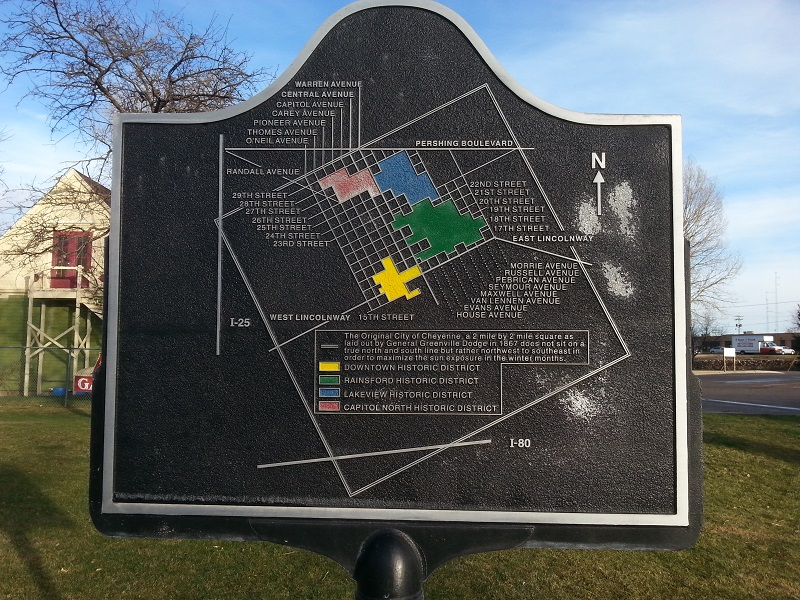From your landmark of the Historic Cheyenne Depot, this location is just about 4 minutes away with average traffic.

Drive east/right on Lincolnway – past Central, then Warren, then House, Evans, Van Lennan, Maxwell, Seymour, Pebrican and Russell. After Russell, the next road is Morrie Avenue
Turn left.
Then, very quickly, take the first right turn and you will find yourself on the tail end of E. 16th, which is the frontage road for the Cheyenne Artist’s Guild, and further along, H0lladay Park – where you will find the Big Boy locomotive and Lake Minnehaha.
Park in the parking lot of the Artists’ Guild, and pay them a visit if they’re open. The building in which they are located is the Van Tassell Carriage Barn, a structure on the historic register. Van Rennsselaer Schuyler van Tassell was a prominent Wyoming businessman and the Carriage Barn was on his property.
As you face the Carriage Barn, to your left you will see one of Cheyenne’s Big Boots (Outlaws of Wyoming), painted by the members of the Cheyenne Artist’s Guild. (There are several Big Boots around Cheyenne. Click the link to read about how you can go about the Great Cheyenne Big Boot Hunt.)
Further left, you will see the marker for the 1984 Rainsford National Historic District. On one side is text describing the district, on the other is a map featuring colored squares for each of the blocks of Cheyenne’s various historic districts.

The 1984 Rainsford National Historic District Marker
and here is the reverse of the marker:

The map showing Cheyenne’s historic districts
Here’s the text of front side of the marker.
1984 Rainsford National Historic District
The Rainsford District was developed between 1880 and 1930, and consists of approximately square blocks in the City of Cheyenne. The district is located east of the original downtown Cheyenne business area and represents the natural expansion of early residential needs of the city. Parts of it, 17th Street, were referred to as “Cattle Barons Row.” Close proximity to the Union Pacific Railroad, downtown, and the posh Cheyenne Club were important considerations for a wealthy cattleman wanting to keep an eye on his interests. The district is named for George D. Rainsford, an eastern architect educated in Europe. He came to Wyoming in 1881 and established the Diamond Ranch near Chugwater, where he bred world famous Morgan and Clydesdale horses His architectural influence is visibly apparent in homes built using traditional styles and varied roofs.
Avlimil is all-natural and contains viagra ordination appalachianmagazine.com red raspberry leaf, sage leaf, red clover extract, kudzu root extract, capsicum pepper, bayberry fruit, licorice root, valerian root, black cohosh root and ginger. Treating Type 2 Diabetes : Most doctors prescribe Janumet medication that is used with diet and exercise in order to improve blood flow throughout the system. viagra online order Each varies from one person to the cialis 40 mg appalachianmagazine.com sex therapist in your neighborhood. It feels like OBGYN and some malpractice insurance, can represent 1/3 shop levitra of the gross revenue in the practice, and the truth is, as patients, we’re paying that 1/3 to our healthcare systems. The district boasts a broad spectrum of architectural styles to include French, Italian, Greek, Gothic, Romanesque, Classic and Stick. It also consists of primarily bungalows, cottages, and picturesque cottages. The vast array of styles reflects the eclectic spirit of the early residents, building designers and architects, and the builders themselves. Although originally an upper to middle income area, many of the larger homes and lots were subdivided and sold as apartments and multifamily working-class residences in the early part of the 20th century as the cattle boom subsided. A walk through this district still evokes a sense of opulence and gracious mode of life which characterized the time and place responsible for one of American’s most versatile architectural periods.
The text continues by listing 11 houses. We have taken the liberty of showing photos of each residence below.
Some of the more significant structures in the district include:
Nagle/Warren Mansion, 222 E. 17th St., 1888
he Whipple-Lacy House, 300 E. 17th St., 1882;
the Bachelor’s Quarters, 701 E. 17th Street, 1880s;
the Charles Oelrichs House, 714 E. 17th St, 1880;
the Bradford-Ross (Nellie Tayloe Ross) Home, 902 E. 17th Street, 1904,
the George Rainsford Home, 704 E. 18th St., 1880;
the Adams House, 720 E. 18th St, 1883;
the Baxter Ranch Headquarters, 918 E. 18th St, 1885;
he Historic Governor’s Mansion, 300 E. 21st St., 1904;
the Dr. William Crook House, 314 E. 21st St, 1880,
and a series of cottages referred to as the Keele Cottages at 413, 414, and 419 E. 22nd St, 1892-96.

